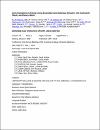Joint Associations of Activity Energy Expenditure and Sedentary Behaviors with Adolescent's Obesity and Dietary Habits
| Author | Al-Hazzaa, Hazzaa M. |
| Author | Al-Sobayel, Hana I. |
| Author | Abahussain, Nada A. |
| Author | Qahwaji, Dina M. |
| Author | Al-Haifi, Ahmad R. |
| Author | Desoki, Tamer E. |
| Author | Kilani, Hashem A. |
| Author | Musaiger, Abdulrahman O. |
| Author | Kerkadi, Abdelhamid |
| Available date | 2016-11-16T06:16:05Z |
| Publication Date | 2014-05 |
| Publication Name | Medicine and Science in Sports and Exercise |
| Citation | Al-Hazzaa, Hazzaa M.; Al-Sobayel, Hana I.; Abahussain, Nada A.; Qahwaji, Dina M.; Al-Haifi, Ahmad R.; Desoki, Tamer E.; Kilani, Hashem A.; Musaiger, Abdulrahman O.; Kerkadi, Abdelhamid "Joint Associations of Activity Energy Expenditure and Sedentary Behaviors with Adolescent's Obesity and Dietary Habits" MEDICINE AND SCIENCE IN SPORTS AND EXERCISE (2014) 46:5 61st Annual Meeting of the American College of Sports Medicine |
| ISSN | 0195-9131 |
| Abstract | PURPOSE: Physical inactivity and sedentary behaviors are thought to be independent entities and differently associate with adverse health outcomes. Thus, the aim of this study was to investigate the joint associations of physical activity and sedentary behaviors with obesity indices and dietary habits among adolescents from the Gulf Cooperation Council (GCC) countries. METHODS: Data were from the Arab Teens Lifestyle Study (ATLS), a school based, cross-sectional lifestyle study. The present analysis included 6279 adolescents (49.4% males) aged 14-20 years, randomly selected from eight major cities in the GCC countries, using a multistage stratified cluster sampling technique. Anthropometric and self-reported lifestyle data were obtained from participants. Adolescents were classified into four categories: high active & low sedentary (HA-LS), high active & high sedentary (HA- HS), low active & low sedentary (LA-LS) and low active & high sedentary (LA-HS), based on cut off scores of total activity energy expenditure and daily screen time above and below 1680 METs-min/week and above or below 3 hours/day, respectively. RESULTS: Results of MANCOVA tests controlling for age revealed that compared with those with LA-HS, adolescents with HA-LS had signifi cantly (<0.001) lower mean (SD) values for BMI (22.6 (5.5) vs 23.7 (6.2)), waist to height ratio (0.45 (.07) vs 0.48 (.08)), and less frequent intakes of sugar-sweetened drinks (3.7 (2.5) vs 4.5 (2.3)), fast foods (2.2 (1.9) vs 2.9 (1.9)), French fries/potato chips (2.1 (2.0) vs 2.9 (2.1)), cakes/donuts (2.4 (2.1) vs 2.7 (2.1)) and sweets (2.5 (2.1)) vs 3.8 (2.3) but more frequent intakes of breakfast (3.9 (2.7) vs 3.3 (2.6)), vegetables (4.4 (2.3) vs 3.5 (2.4)), fruits (4.2 (2.3) vs 2.8 (2.2)) and milk (4.3 (2.5) vs 3.6 (2.5)). CONCLUSIONS: Adolescents with combined high activity energy expenditure and low sedentary behaviors tend to have lower risk of obesity and have more favorable (healthy) dietary habits. These findings carry important implications for adolescent’s health promotion and obesity prevention. |
| Sponsor | American College of Sports Medicine |
| Language | en |
| Publisher | Lipincott, Williams, & Wilkins |
| Subject | Activity Energy Expenditure Sedentary Behaviors Adolescent’s Obesity dietary habits Arab Sport Science |
| Type | Conference |
| Issue Number | 5 |
| Volume Number | 46 |
| ESSN | 1530-0315 |
Files in this item
This item appears in the following Collection(s)
-
Health Sciences-CAS (pre 2016) [151 items ]


